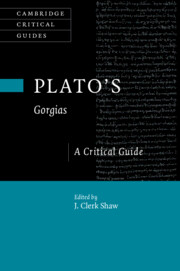Refine search
Actions for selected content:
23 results
Chapter 4 - Plato’s Definition of Tragedy
-
- Book:
- Plato on Comedy and Tragedy
- Published online:
- 24 October 2025
- Print publication:
- 13 November 2025, pp 125-163
-
- Chapter
- Export citation
Chapter 5 - Tragedy and the Best Life in the Gorgias
-
- Book:
- Plato on Comedy and Tragedy
- Published online:
- 24 October 2025
- Print publication:
- 13 November 2025, pp 164-187
-
- Chapter
- Export citation

Plato on Comedy and Tragedy
- The Role of Drama in the Pursuit of Happiness
-
- Published online:
- 24 October 2025
- Print publication:
- 13 November 2025
Chapter 1 - Rhetoric in Athens
-
- Book:
- Democracy, Theatre and Performance
- Published online:
- 17 May 2024
- Print publication:
- 27 June 2024, pp 19-38
-
- Chapter
- Export citation
Chapter 5 - The Ethical Function of the Gorgias’ Concluding Myth
-
-
- Book:
- Plato's Gorgias
- Published online:
- 25 May 2024
- Print publication:
- 30 May 2024, pp 87-104
-
- Chapter
- Export citation
Chapter 1 - Gorgias of Leontini and Plato’s Gorgias
-
-
- Book:
- Plato's Gorgias
- Published online:
- 25 May 2024
- Print publication:
- 30 May 2024, pp 7-26
-
- Chapter
- Export citation
Chapter 3 - Philosophy and the Just Life in the Gorgias
-
-
- Book:
- Plato's Gorgias
- Published online:
- 25 May 2024
- Print publication:
- 30 May 2024, pp 48-67
-
- Chapter
- Export citation

Plato's Gorgias
- A Critical Guide
-
- Published online:
- 25 May 2024
- Print publication:
- 30 May 2024
8 - Gorgias’ Funeral Oration
- from Part III - The Literary Examples
-
-
- Book:
- The Athenian Funeral Oration
- Published online:
- 11 January 2024
- Print publication:
- 01 February 2024, pp 181-197
-
- Chapter
- Export citation
7 - Problems of Being
- from Part II - Thought
-
-
- Book:
- The Cambridge Companion to the Sophists
- Published online:
- 23 December 2023
- Print publication:
- 19 October 2023, pp 200-224
-
- Chapter
- Export citation
Introduction
-
- Book:
- How Plato Writes
- Published online:
- 27 July 2023
- Print publication:
- 17 August 2023, pp 1-12
-
- Chapter
- Export citation
Chapter 4 - Greek Historiography between Fiction and Truth
-
- Book:
- The Greeks and Their Histories
- Published online:
- 01 December 2022
- Print publication:
- 15 December 2022, pp 95-132
-
- Chapter
- Export citation
3 - Psychological Foundations in Ancient Greece
- from Part I - Psychology’s Historical Foundations
-
- Book:
- History and Systems of Psychology
- Published online:
- 04 November 2022
- Print publication:
- 17 November 2022, pp 36-58
-
- Chapter
- Export citation
Chapter 6 - Friendship Terms in Plato
- from Part III - Im/Politeness in Use
-
-
- Book:
- Politeness in Ancient Greek and Latin
- Published online:
- 08 September 2022
- Print publication:
- 08 September 2022, pp 147-174
-
- Chapter
- Export citation
11 - Plato on Poetic Creativity: A Revision
-
-
- Book:
- The Cambridge Companion to Plato
- Published online:
- 21 July 2022
- Print publication:
- 04 August 2022, pp 328-357
-
- Chapter
- Export citation
Chapter 1 - Gorgias and the Justice of Tragic Apatē
-
- Book:
- The Ancient Aesthetics of Deception
- Published online:
- 23 August 2021
- Print publication:
- 16 September 2021, pp 1-32
-
- Chapter
- Export citation
Epilogue: The Legacy of Presocratic Poetics
-
- Book:
- Poetry and Poetics in the Presocratic Philosophers
- Published online:
- 05 April 2021
- Print publication:
- 15 April 2021, pp 183-206
-
- Chapter
- Export citation
Part I - Poetry in Rhetoric
-
- Book:
- Persuasion, Rhetoric and Roman Poetry
- Published online:
- 08 August 2019
- Print publication:
- 22 August 2019, pp 7-132
-
- Chapter
- Export citation
Chapter 1 - Poetry and Rhetoric and Poetry in Rhetoric
- from Part I - Poetry in Rhetoric
-
- Book:
- Persuasion, Rhetoric and Roman Poetry
- Published online:
- 08 August 2019
- Print publication:
- 22 August 2019, pp 9-45
-
- Chapter
- Export citation
Chapter 5 - Order and Orderliness
-
-
- Book:
- Cosmos in the Ancient World
- Published online:
- 18 June 2019
- Print publication:
- 04 July 2019, pp 108-121
-
- Chapter
- Export citation
